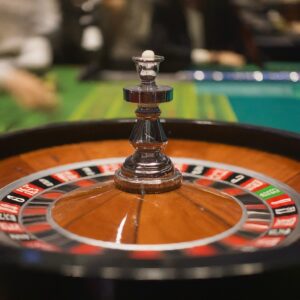The Roulette Wheel Guide: the Game’s Spinning Heart
Roulette’s allure is intrinsically linked to its mesmerizing wheel. This spinning centerpiece is more than just a random number generator; it’s a carefully engineered marvel that embodies the essence of chance and anticipation. In this guide, we’ll delve into the intricacies of the roulette wheel, exploring its design, variations, and the role it plays in determining the game’s outcome.
Anatomy of a Roulette Wheel

The roulette wheel is a circular disc divided into numbered pockets. These pockets alternate in red and black, with a green pocket for the 0 (and 00 in American roulette). The wheel is mounted on a spindle and spun by a croupier. A small ball is then released onto the spinning wheel, eventually landing in one of the pockets to determine the winning number.
Types of Roulette Wheels
There are three main types of roulette wheels:
- European Roulette Wheel: This wheel has 37 pockets (1-36, 0) and is the most common type found in casinos worldwide. It offers the best odds for players due to its lower house edge.
- American Roulette Wheel: This wheel has 38 pockets (1-36, 0, 00). The additional 00 pocket increases the house edge, making it slightly less favorable to players.
- French Roulette Wheel: This wheel is similar to the European wheel, but it also features the “La Partage” and “En Prison” rules, which can further reduce the house edge in certain situations.
Understanding the Wheel Layout
The numbers on a roulette wheel are not arranged randomly. They follow a specific pattern designed to balance the distribution of high and low numbers, as well as red and black numbers.
- European Wheel Layout: The numbers are arranged in a seemingly random order, but they follow a pattern where high and low numbers, as well as red and black numbers, are evenly dispersed.
- American Wheel Layout: The layout is similar to the European wheel, but the 00 pocket is placed opposite the 0 pocket.
The Role of the Wheel in Determining Outcomes
The roulette wheel is the ultimate arbiter of chance in the game. The speed at which the wheel is spun, the angle at which the ball is released, and even minor imperfections in the wheel can all influence where the ball lands. This unpredictability is what makes roulette so exciting.
The Importance of Wheel Bias
While roulette wheels are designed to be as random as possible, they can sometimes develop biases due to wear and tear or manufacturing imperfections. These biases can cause certain numbers to hit more frequently than others. Professional roulette players often look for biased wheels to gain an advantage over the house.
Tips for Playing Roulette
- Choose the right wheel: If you have the option, play European roulette as it offers better odds than American roulette.
- Understand the odds: Different bets have different payouts, so it’s important to know the odds before you place your bets.
- Manage your bankroll: Set a budget for yourself and stick to it. Don’t chase losses.
- Look for biased wheels: If you’re an experienced player, you can try to spot biased wheels to increase your chances of winning.
- Have fun! Roulette is a game of chance, so enjoy the thrill of the spin!
